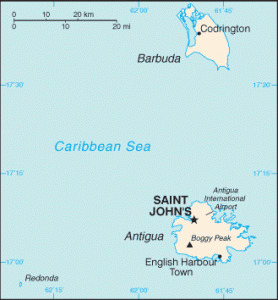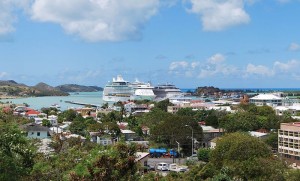Antigua and Barbuda
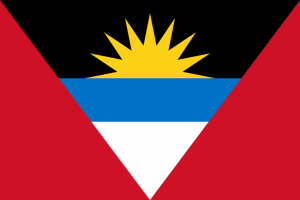
Antigua
Destination video guide to the Caribbean island of Antigua. Featuring fabulous food, luxurious island living, and plenty of activities including Helicopter rides, Powerboat trips, history and Rainforest canopy ziplines, it’s a must see for anyone planning a trip to one of the Caribbean’s best kept secrets.
Antigua and Barbuda (![]() i/ænˈtiːɡə ænd bɑrˈbjuːdə/; Spanish for “ancient” and “bearded”) is a twin-island nation lying between the Caribbean Sea and the Atlantic Ocean. It consists of two major inhabited islands, Antigua and Barbuda, and a number of smaller islands (including Great Bird, Green, Guinea, Long, Maiden and York Islands and further south, the island of Redonda). The permanent population numbers approximately 81,800 (at the 2011 Census) and the capital and largest port and city is St. John’s, on Antigua.
i/ænˈtiːɡə ænd bɑrˈbjuːdə/; Spanish for “ancient” and “bearded”) is a twin-island nation lying between the Caribbean Sea and the Atlantic Ocean. It consists of two major inhabited islands, Antigua and Barbuda, and a number of smaller islands (including Great Bird, Green, Guinea, Long, Maiden and York Islands and further south, the island of Redonda). The permanent population numbers approximately 81,800 (at the 2011 Census) and the capital and largest port and city is St. John’s, on Antigua.
Separated by a few nautical miles, Antigua and Barbuda are in the middle of the Leeward Islands, part of the Lesser Antilles, roughly at 17 degrees north of the Equator. The country is nicknamed “Land of 365 Beaches” due to the many beaches surrounding the islands. Its governance, language, and culture have all been strongly influenced by the British Empire, of which the country was formerly a part.
History of Antigua and Barbuda
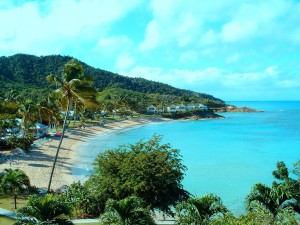 Antigua was first settled by Archaic Age hunter-gatherer Amerindians called the Siboney or Ciboney. Carbon-dating has established that the earliest settlements started around 3100 BC. They were succeeded by the Ceramic Age pre-ColumbianArawak-speaking Saladoid people who migrated from the lower Orinoco River.
Antigua was first settled by Archaic Age hunter-gatherer Amerindians called the Siboney or Ciboney. Carbon-dating has established that the earliest settlements started around 3100 BC. They were succeeded by the Ceramic Age pre-ColumbianArawak-speaking Saladoid people who migrated from the lower Orinoco River.
The Arawaks introduced agriculture, raising, among other crops, the famous Antigua Black Pineapple (Moris cultivar of Ananas comosus), corn, sweet potatoes (white with firmer flesh than the bright orange “sweet potato” used in the United States), chiles, guava, tobacco and cotton.
The indigenous West Indians made excellent seagoing vessels which they used to sail the Atlantic and the Caribbean. As a result, Caribs and Arawaks were able to colonize much of South America and the Caribbean Islands. Their descendants still live there, notably in Brazil, Venezuela and Colombia.
Most Arawaks left Antigua around 1100 AD; those who remained were later raided by the Caribs. According to the Catholic Encyclopedia, the Caribs’ superior weapons and seafaring prowess allowed them to defeat most of the West Indian Arawak nations, enslaving some and possibly cannibalizing others.
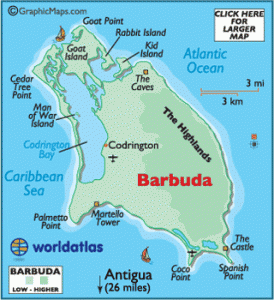 The Catholic Encyclopedia does make it clear that the European invaders had some difficulty differentiating between the native peoples they encountered. As a result, the number and types of ethnic/tribal groups in existence at that time may have been much more varied and numerous than just the two mentioned in this article.
The Catholic Encyclopedia does make it clear that the European invaders had some difficulty differentiating between the native peoples they encountered. As a result, the number and types of ethnic/tribal groups in existence at that time may have been much more varied and numerous than just the two mentioned in this article.
European and African diseases, malnutrition and slavery eventually killed most of the Caribbean’s native population, although no researcher has conclusively proven any of these causes as the real reason for these deaths. Smallpox was probably the greatest killer. In fact, some historians believe that the psychological stress of slavery may also have played a part in the massive number of deaths amongst enslaved natives. Others believe that the reportedly abundant, but starchy, low-protein diet may have contributed to severe malnutrition of the Amerindians, who were used to a diet fortified with protein from the sea.
The island of Antigua, originally called “Wa’ladli” by Arawaks, is today called “Wadadli” by locals. It is possible that Caribs called it “Wa’omoni.” Christopher Columbus, while sailing by in 1493, may have named it Santa Maria la Antigua after an icon in the Spanish Seville Cathedral. The Spaniards did not colonize Antigua because it lacked fresh water but not aggressive Caribs.
The English settled on Antigua in 1632; Sir Christopher Codrington settled on Barbuda in 1684. Slavery, established to run sugar plantations around 1684, was abolished in 1834. The British ruled from 1632 to 1981, with a brief French interlude in 1666.
The islands became an independent state within the Commonwealth of Nations on 1 November 1981, with Elizabeth II as the first Queen of Antigua and Barbuda. The Right Honourable Vere Cornwall Bird Sr became the first Prime Minister.
Governance – Politics of Antigua and Barbuda
The politics of Antigua and Barbuda take place within a framework of a unitary, parliamentary, representative democratic monarchy, in which the Head of State is the Monarch who appoints the Governor Generalas vice-regal representative. Elizabeth II is the present Queen of Antigua and Barbuda, having served in that position since the islands’ independence from the United Kingdom in 1981. The Queen is currently represented by Governor General Dame Louise Lake-Tack(1944–), who became the first woman to hold this position. A Council of Ministers is appointed by the Governor General on the advice of the Prime Minister, currently Winston Baldwin Spencer (1948–). The Prime Minister is the Head of Government.
Executive power is exercised by the government while legislative power is vested in both the government and the two Chambers of Parliament. The bicameral Parliament consists of the Senate (17 members appointed by members of the government and the opposition party, and approved by the Governor-General), and the House of Representatives (17 members elected by first past the post) to serve five-year terms. The Speaker of the House is author and former St. John’s University professor (New York) D. Giselle Isaac-Arrindell, while the President of the Senate is educator Hazelyn Francis-Mason.
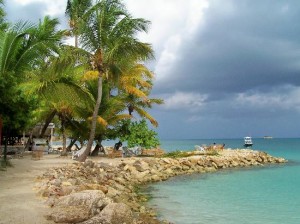 The current Leader of Her Majesty’s Loyal Opposition is Antigua Labour Party Member of Parliament (MP), the Honourable Gaston Alphonso Browne. Browne defeated his predecessor Lester Bryant Bird at the party’s biennial convention in November, 2012 held to elect a political leader and other party officers. Gaston Alphonso Browne renamed the Antigua Labour Party [ALP], to the Antigua & Barbuda Labour Party, ABLP. This was done to officially include the party’s presence on the sister isle of Barbuda in its organization, the only political party on the mainland to have a physical branch in Barbuda.
The current Leader of Her Majesty’s Loyal Opposition is Antigua Labour Party Member of Parliament (MP), the Honourable Gaston Alphonso Browne. Browne defeated his predecessor Lester Bryant Bird at the party’s biennial convention in November, 2012 held to elect a political leader and other party officers. Gaston Alphonso Browne renamed the Antigua Labour Party [ALP], to the Antigua & Barbuda Labour Party, ABLP. This was done to officially include the party’s presence on the sister isle of Barbuda in its organization, the only political party on the mainland to have a physical branch in Barbuda.
The last elections held were on 12 March 2009, during which the Antigua Labour Party won seven seats, the United Progressive Party nine and the Barbuda People’s Movement one.
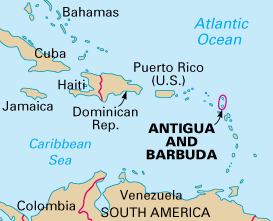 Since 1949, the party system had been dominated by the populist Antigua Labour Party. However, the Antigua and Barbuda legislative election of 2004 saw the defeat of the longest-serving elected government in the Caribbean. Prime Minister Lester Bryant Bird, who had succeeded his father Vere Cornwall Bird Sr., and Deputy Robin Yearwood had been in office since 1994.
Since 1949, the party system had been dominated by the populist Antigua Labour Party. However, the Antigua and Barbuda legislative election of 2004 saw the defeat of the longest-serving elected government in the Caribbean. Prime Minister Lester Bryant Bird, who had succeeded his father Vere Cornwall Bird Sr., and Deputy Robin Yearwood had been in office since 1994.
The elder Bird was Prime Minister from 1981 to 1994 and Chief Minister of Antigua from 1960 to 1981, except for the 1971–1976 period when the Progressive Labour Movement (PLM) defeated his party. Vere Cornwall Bird, the nation’s first Prime Minister, is credited with having brought Antigua and Barbuda and the Caribbean into a new era of independence.
The Judicial Branch is the Eastern Caribbean Supreme Court (based in Saint Lucia; one judge of the Supreme Court is a resident of the islands and presides over the High Court of Justice). In addition, Antigua is a member of the Caribbean Court of Justice. The Supreme Court of Appeal was the British Judicial Committee of the Privy Council up until 2001, when the nations of the Caribbean Community voted to abolish the right of appeal to the Privy Council in favor of a Caribbean Court of Justice. Some debate between member countries repeatedly delayed the court’s date of inauguration. As of March 2005, only Barbados was set to replace appeals to the Privy Council with appeals the Caribbean Court of Justice, which by then had come into operation.
Foreign Relations of Antigua and Barbuda
Antigua and Barbuda is a member of the United Nations, the Bolivarian Alliance for the Americas, the Commonwealth of Nations, the Caribbean Community, the Organization of Eastern Caribbean States, the Organization of American States, the World Trade Organization and the Eastern Caribbean’s Regional Security System.
Antigua and Barbuda is also a member of the International Criminal Court (with a Bilateral Immunity Agreement of Protection for the US military as covered under Article 98).
In 2013, Antigua and Barbuda called for reparations for slavery at the United Nations. “We have recently seen a number of leaders apologising,” said the prime minister Baldwin Spencer. They should now “match their words with concrete and material benefits.”
Economy of Antigua and Barbuda
Tourism dominates the economy, accounting for more than half of the Gross Domestic Product (GDP). Antigua is famous for its many luxury resorts. Weak tourist activity since early 2000 has slowed the economy, however, and squeezed the government into a tight fiscal corner. Investment banking and financial services also make up an important part of the economy. Major world banks with offices in Antigua include the Royal Bank of Canada (RBC) and Scotiabank. Financial-services corporations with offices in Antigua include PriceWaterhouseCoopers. The US Securities and Exchange Commission has accused the Antigua-based Stanford International Bank, owned by Texas billionaire Allen Stanford, of orchestrating a huge fraud which may have bilked investors of some $8 billion. (check status 20100312)
The twin-island nation’s agricultural production is focused on its domestic market and constrained by a limited water supply and a labor shortage stemming from the lure of higher wages in tourism and construction work.
Manufacturing is made up of enclave-type assembly for export, the major products being bedding, handicrafts and electronic components. Prospects for economic growth in the medium term will continue to depend on income growth in the industrialized world, especially in the United States, from which about one-third of all tourists come.
Following the opening of the American University of Antigua College of Medicine by investor and attorney Neil Simon in 2003, a new source of revenue was established. The university employs many local Antiguans and the approximate 1000 students consume a large amount of the goods and services.


